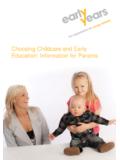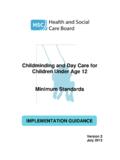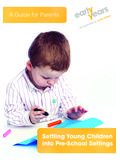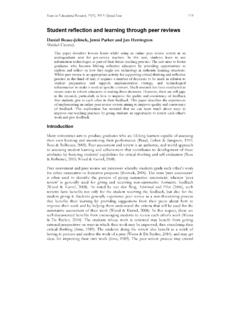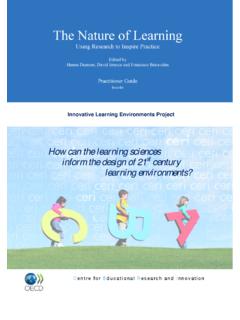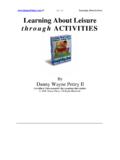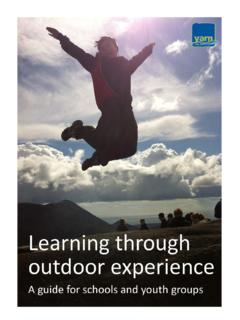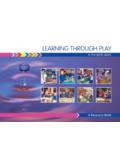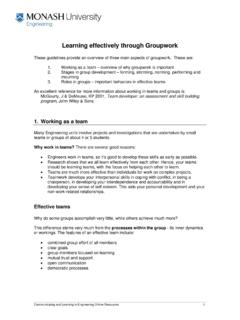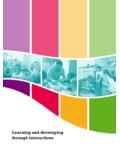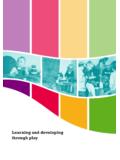Transcription of learning through physical play - Early Years
1 Children develop in a holistic manner. physical development should be seen as being important in young children s development as intellectual development. Research has shown that physical activity in young children can enhance concentration, motivation, learning and , our lives have become more inactive and our children have less opportunity for physical activity each day. The reasons for our increased inactivity include: Excessive television viewing Fewer family members to play with Fewer safe outside play areasPreschools can provide many opportunities for physical play to promote fi ne and gross motor skills and hand / eye enjoy physical play , indoors and outdoors.
2 They revel in freedom of movement and in play that is inventive, adventurous and stimulating. Children also learn social skills as they cooperate with one another and show consideration for one Muscle Development gross motor and locomotor skills Walk forwards, backwards and sideways Walk on tip-toes (balance) Running, stopping and starting Climb up steps or a ladder with one foot leading Pivot around and around on feet Jump up and down on the spot on both feet Jump a distance Balance along a plank 18cms from the ground Balance on one leg for 4 seconds Crawl through a barrel or tunnelThese basic activities develop body management, balance, bodily co-ordination, strength, agility and confi through physical PlayFine Motor Skills Building blocks Assembling construction materials Duplo etc.
3 Putting Jigsaws together Grip a pencil or paintbrush Hammer shapes into a pegboard Pour water or dry sand from one container to another Thread beads Manipulate PlaydoughThese activities promote hand-eye coordination, spatial awareness, fi ne motor control, accuracy, two handed coordination and manipulative Hand & Eye Foot Coordination Skills Catch a large ball between extended arms Kick a ball Pedal a tricycle along a straight line Push a large ball away towards a target Pull an empty truck around obstaclesThese activities promote spatial awareness, hand eye coordination, strength and foot & leg & Junk Holding Brushes, pencils (fi ne motor skills) Cutting Spreading glue and paint Sprinkling glitter (fi ne fi nger movement)
4 Imaginative play Manipulating fastenings on dressing up clothes and dolls (fi ne manipulative skills) Pressing telephone buttons Writing shopping lists Wrapping parcels Using dustpan and brush Coordination in pretend cooking setting the tableSand and Water Pouring, fi lling, stirring, pushing, pulling, moulding, digging, patting (developing fi ne motor skills) Manipulating tools Pouring into containers (Hand eye coordnation) Use equipment with skillPhysical and Outdoor play Throwing and catching Rolling Carrying and passing Climbing Swinging Sliding Cycling / driving wheeled toys Dancing Moving to action rhymesSmall World Manipulating play people, farm animals, vehicles (fi ne motor skills and coordination) Threading beads Cars into the garage (hand eye coordination) Putting furniture in the houseConstruction play Manipulate a range of construction equipment (fi ne and large motor skills)
5 Lifting, carrying Develop skills in fi tting together and taking apart materials (develop hand eye coordination and spatial awarenessPractical play ideas to use at Home with young childrenYoung children s joy in movement leads to healthy growth by encouraging them to challenge and exercise their own bodies. physical play is fun!A healthy child has lots of energy. He/she needs opportunities to crawl, run, dance, climb, balance and these skills help his/her bones and muscels we need for physical play is:- SPACE. This could be a park or garden, the beach or fi eld or a playground.)
6 Space is run freely. Safe equipment and safe surfaces Large equipment such as climbing frames, see saws, planks, tyres and stepping stones. Small equipment such as balloons, balls, bean bags, hoops, skipping ropes, streamers, trikes, bikes and cars. Lots of enthusiasm and energyPhysical activities should not be beyond a child s capability. We can play simple games of catch with our children Hop-Scotch, Follow the Leader, Statues, Skipping, Ring-A-Ring-A-Rosie, Throwing and Catching games and great deal rests on the acquisition of fi ne motor skills. Children need these skills in order to become competent in many areas of life: Writing Handling tools Craft skills Using cutlery Holding brushes Handling delicate things, including living things Turning the pages of booksIn order to accomplish these tasks children need lots of help and practice in using the fi ne muscles of hands, arms and fi ngers.
7 We can provide many play activities to help stimulate this development. Clay and dough Large beads to thread Cars, farms, doll houses Books with pages to turn, fl aps and lift up sections Dressing dolls / action man Paint brushes, crayons and pencilsFor further ideas on learning through play , get a copy of our publication I Want To play , available at the Early Years information and resource centre.

